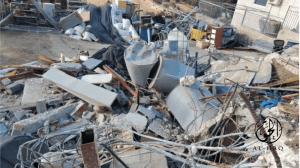On 11 November 2024, Israel’s far-right Finance Minister, Bezalel Smotrich, met with his far-right faction at the Israeli Parliament and announced his intention to lead “the government of Israel [to] work with the new administration of President Trump and the international community to apply Israeli sovereignty over [the West Bank]”.[1] To this end, he instructed the Settlement Administration at the Defence Ministry and the Civil Administration to lay the groundwork for annexation and prepare the necessary infrastructure to apply Israeli sovereignty over the West Bank.[2] This is in line with the Israeli Government’s guiding principles of 2022, which pledged to lead to the formulation and promotion of a policy to extend Israeli sovereignty over the West Bank.[3]
As the Israeli Finance Minister and a minister in the Defence Ministry, Smotrich has been spearheading settlement expansion and annexation in the occupied Palestinian territory (oPt). With the transfer of settlement issues to the Settlement Administration, and the transfer of authority from the head of the Civil Administration to a “Civilian Deputy” directly under Smotrich, the government has accelerated approval of settlements establishment. Smotrich’s plan includes increasing the settler population in the West Bank by 500,000, including an improvement of infrastructure in the settlements and illegal outposts.[4]
In January 2025, while Israel has been carrying out a large scale military assault on the northern West Bank,[5] a bill was advanced in the Israeli Parliament (the Knesset) to annul the applicable Jordanian law governing the West Bank, “The Law on Leasing and Selling Real Estate to Foreigners, No. 40, 1953”, to open up the sale of Palestinian West Bank lands to Israeli settlers.[6] In February 2025, Israel’s Ministerial Committee for Legislation, examined a bill to progress the annexation of West Bank settlements Ma’ale Adumim, Givat Ze'ev, Efrat, and Ma’ale Mikhmas located around Jerusalem.[7] On 23 March, Israel’s Political Security Cabinet approved Minister Smotrich’s proposal to “split 13 [settlement] localities in [the West Bank] from their adjacent localities and to work towards recognizing them as independent localities” thereby “normalis[ing]” the settlements by recognising them as independent entities, while approving “tens of thousands of [settlement] housing units”.[8] On 24 March, Israel’s Minister for Agriculture, Avi Dichter, encouraged, “We’re at a crucial historic opportunity that must not be missed; the time has come to apply Israeli sovereignty over [the West Bank]”.[9]
Extending Israel’s sovereignty over the oPt amounts to purported annexation. One essential tool used by Israel to carry out its annexation of the West Bank is the strategic fragmentation of the Palestinian people through discriminatory inhumane acts of apartheid.[10] The 1995 Israeli-Palestinian Interim Agreement on the West Bank and the Gaza Strip (Oslo II Accord) divided the West Bank into three areas: Area A under full Palestinian civil and security control, Area B under full Palestinian civil control and joint Israeli-Palestinian security control, and Area C under full Israeli civil and military control, which comprises more than 60 percent of the West Bank. The occupied West Bank has been systematically fragmented into hundreds of separate enclaves or ‘Bantustans’ by Israel’s ever-growing settlement enterprise, where a total of 737,332 Israeli settlers are living in a total of 147 Israeli settlements and 224 outposts in the West Bank.[11]
The year 2024 witnessed an acceleration in Israel’s annexation plans and practices. By 20 March 2025, Minister Smotrich announced “an annual record for approvals for housing units in Gush Etzion, and we are only in the first third of the year. We are leading a revolution in [the West Bank]- to strengthen our sovereignty”.[12] Approximately half of all the land declared as state land since the Oslo Accords were declared in 2024.[13] At least 59 new outposts have been established, most of them pastoral outposts, while at least 8 outposts have been established in Area B for the first time since the Oslo Accords.[14] Additionally, Israel is further extending its jurisdiction in Area B, including in archaeological sites, whereby the Israeli Civil Administration can restrict development and carry out demolitions following an Israeli cabinet decision.[15] Also, on 18 July 2024, the Israeli Commander of the Central Command signed two orders granting Israel enforcement, planning, and building authorities in territories transferred under the Oslo Accords to the Palestinian Authority, including demolition of Palestinian structures in Area B.[16] Demolition orders were issued and some were enforced as will be highlighted below.
Read the Special Focus in full here, which highlights increased demolitions of Palestinian structures as documented by Al-Haq in Ni'lin, Beit Awwa, and Al-Malha.
[1] Anadolu Ajansi, “What Trump’s second term could mean for the Middle East”,15 November 2024, at: https://www.aa.com.tr/en/americas/what-trump-s-second-term-could-mean-for-the-middle-east/3394966.
[2] Al-Jazeera, “Israel’s Smotrich orders prep work for annexation of occupied West Bank”, 11 November 2024, available at: https://www.aljazeera.com/program/newsfeed/2024/11/11/israels-smotrich-orders-prep-work-for-annexation-of-occupied-west-bank.
[3] Adalah, “Adalah’s Analysis of the New Israeli Government’s Guiding Principles and Coalition Agreements and their Implications on Palestinians’ Rights”, 10 January 2023, at: https://www.adalah.org/en/content/view/10770.
[4] Haaretz, “Far-right Israeli Minister Lays Groundwork for Doubling West Bank Settler Population”, 18 May 2023, at: https://www.haaretz.com/israel-news/2023-05-18/ty-article/.premium/far-right-israeli-minister-lays-groundwork-for-doubling-west-bank-settler-population/00000188-2de6-d6e4-ab9d-ede74a3e0000. For more on settler road network and annexation, see Madar Center, “Settler Road Network – Annexation Infrastructure”, 25 March 2025, at: https://tinyurl.com/mry7tva3.
[5] Al-Haq, “Action Alert: Urgent Need for Protection of Palestinians as Israel Intensifies Its Genocidal, Colonial Violence in the West Bank, including in Jenin and Tulkarem”, 29 January 2025, at: https://www.alhaq.org/advocacy/25868.html
[6] “Approved in preliminary reading: Annulment of Jordanian law applied in Judea and Samaria regarding lease and sale of real estate to foreigners”, 30 January 2025, at: https://main.knesset.gov.il/en/news/pressreleases/pages/press30125q.aspx; @limor_sonhrmelh, (3:42 pm, 29 January 2025), https://x.com/limor_sonhrmelh/status/1884628103462363576
[7] Noa Shipgel, “'Major Step to Full Sovereignty': Bill to Annex West Bank Settlements Near Jerusalem Set to Pass” Haaretz, 28 February 2025, at: https://www.haaretz.com/israel-news/2025-02-28/ty-article/.premium/step-to-full-sovereignty-law-to-annex-west-bank-settlements-near-jerusalem-set-to-pass/00000195-4c3f-d79a-abfd-fdff5ab10000; Arieh King @arieh_king, (8:31 pm, 27 February 2025), https://x.com/arieh_king/status/1895210228666577107
[8] @bezalelsm, (5:14 am, 23 March 2025), https://x.com/bezalelsm/status/1903676584210424217
[9] “Dichter: ‘Time to apply Israeli sovereignty over Judea and Samaria’” JNS (24 March 2025), https://www.jns.org/dichter-time-to-apply-israeli-sovereignty-over-judea-and-samaria/
[10] Al-Haq et al, “Israeli Apartheid: Tool of Zionist Settler Colonialism”, 29 November 2022, available at: https://www.alhaq.org/publications/20940.html
[11] Peace Now, https://peacenow.org.il/en/settlements-watch/settlements-data/population. See also, OHCHR, Israeli settlements in the Occupied Palestinian Territory, including East Jerusalem, and in the occupied Syrian Golan (Report), 6 March 2025, A/HRC/58/73, at: https://www.ohchr.org/en/documents/country-reports/ahrc5873-israeli-settlements-occupied-palestinian-territory-including.
[12] @bezalelsm (7:09 pm, 20 March 2025), https://x.com/bezalelsm/status/1902799619852996893
[13] In June 2024, the Custodian of the State’s Property in the Civil Administration declared 12,700 dunams at the Jordan Valley as state lands, the largest declaration as such since the Oslo Accords, Peace Now, “The Government Declares 12,000 Dunams in the Jordan Valley as State Lands”, 3 July 2024, at: https://peacenow.org.il/en/state-land-declaration-12000-dunams.
[14] Peace Now, “The Year of Annexation and Expulsion: Summary of Settlement Activity in 2024”, 6 February 2025, at: https://peacenow.org.il/en/the-year-of-annexation-and-expulsion-summary-of-settlement-activity-in-2024.
[15] Emek Shaveh, “Cabinet Decision to Allow Israeli Civil Administration Jurisdiction at Heritage Sites in Area B of the West Bank”, 4 July 2023, at: https://emekshaveh.org/en/cabinet-decision-area-b/.
[16] Peace Now, “Israeli Government Assumes Authorities of the Palestinian Authority in Area B”, 19 July 2024, at: https://peacenow.org.il/en/israeli-government-assumes-authorities-of-the-palestinianauthority-in-area-b.


